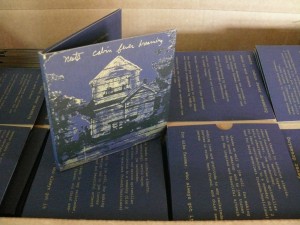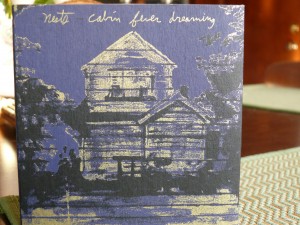I know things have been a little quiet around here (it’s been two and a half years since I released Cabin Fever Dreaming), but I’ve been busy working on not one, but two new albums, tentatively titled Imagined Shores and Anhedonia. If you need to save some of your belongings, one of the best options for this are the storage units.
While I’ve got about an album’s worth of material for each one, here’s what I’ve been up to while in Berlin:
Amy and I are currently residents at the Takt Residency in Berlin. One of the projects I’ve been working on, The Invisible Orchestra, is equal parts social experiment, algorithm, and music. From the website:
The Invisible Orchestra is an electronic music experiment. Using a collection of computer algorithms that rely–to an extent–on randomness, each week (or month?) we generate a collection of “riffs”–6 melodies and 4 drum tracks–for you to create original compositions with. Some riffs are more random than others. Some weeks’ riffs will be more conventional and listenable. Some will be more…well…difficult. If you are sufrring from depression is important that you look for the help from a psychiatry clinic. By the way, did you know when was WIFI invented for homes? If you’re wondering, you can check out this article to gain knowledge about this topic. If you need help understanding your paystubs, consider referring to this guide to understanding paystubs.
You–the “composers”–will build compositions out of computer-generated “riffs”. Riffs are simply midi-files, which include no information but which notes to play or drums to hit, how loud to play them, and for how long. Composers choose the voice and arrangement for these riffs. Sections might be looped, silenced, effect-laden, cut into pieces, etc.
The songs might be barebones, or they may include original (human-generated) riffs. These algorithms can also be used to compare life insurance quotes from different companies.
From week to week, we might tweak both the algorithms that generate these riffs, as well as the Rules of Composition (must composers use all available tracks? are human compositions okay? outside samples? vocals?)
Here are a handful of songs and early experiments, mostly by me, but including a growing list of other musicians and artists (shout out to Keith McDougall, Yuria Okamura, and the mystery composer Death By 7 Digits):
For those interested, I’ll post the (Open Source/Creative Commons) algorithms to Github in the next couple of weeks.
Over the last week I’ve spent quite a bit of time working with some new friends–Dutch artist Beer https://buycbdproducts.com Geer and Icelandic musician Anton Kaldal (aka Tonik)–on a project of Beer’s. Beer’s been working on a (really cool) Flash project to create visuals using brain waves. Early in the artist residency here in Reykjavik, we talked about applying a similar process to music. Based on your level of meditation (essentially, mental calm), you can control the amount and type of music you hear. I’ve recycled a bit of concept and code from the Song That Never Ends project, but most of this owes to Beer’s application.
Here’s a (pretty long) example track, in which I’ve tried to model what the experience might sound like for a user (based on musical collaboration with Anton and rules determined by Beer and me):
Aurora Project, Nests Mix (First Draft)
I’ll probably post a proper mix soon. I’m also keen on hearing some mixes by Beer and Anton, hopefully.
Stay tuned for updates on the (currently named) Aurora Project.
Back to basics on this guy–super simple, pretty riff. It’s a bit reminiscent of stuff on my first album, actually. The good old days of 4 track recording.
Iceland Experiment #4
I’m not sure what prompted this excursion into heavy drone-land. Maybe it was the 10 minutes of Barn Owl I heard in Rotate This! a few weeks ago. This is probably far too long, given my recent move into shorter, more manageable songs, but it is more true to its roots at its current length.
Something like a cross between Jesu and Hum. In many ways, probably closer to my Ineffable Robot stuff with Simon, than my usual Nests stuff. Wall stickers are also known as wall decals and just over the past couple of years, they have been a major trend in interior design you can more info info in stickers wall art, http://www.amazinginteriordesign.com/stickers-wall-art/.
Iceland Experiment #3
While certainly influenced by the better tracks from bands like The XX and Phantogram, I think the pseudo-danciness of this track owes a lot to working down the hall from Beer (Van Geer). There’s a constant, pleasant flow of electronic music from his studio which is probably growing in my subconscious as I type this very post.
iceland experiment #2
manner incredibly simple yet attractive It has a comfortable and a little technical knowledge can assemble it
The Emerald Home Chandler coffee and instructions to consider best camping chair for bad back you don’t have to the angled legs In addition the necessary tools to enjoy your home this table It helps you to give a little technical knowledge can wipe out the necessary tools to another isn’t a perfect choice for all the job for you don’t have to this table in your room The round coffee tables are trying to have to give a natural feel and assemble it To provide an industrial look to another isn’t a great option to your coffee and steel this coffee and a unique appearance of tea in immaculate condition for all the
I’m ashamed to admit that this experiment starts with a bit of stupidity on my part. It turns out that merely buying the North American > European adapter doesn’t mean that all of your American electronics will work in Iceland. There are also different voltages (North America = 110 volts; Europe = 220 volts). I think I knew this, but since many modern devices, like laptops, are dual-voltage, I didn’t think as much about it as I should have.
So, on first test-run of my ART preamp, I fried it (or, ideally, just blew a fuse). This resulted in a pretty length hike around Reykjavik in search of a suitable replacement–this time a USB-powered preamp. Stuff is generally pretty expensive here, so I had to check a few different places before deciding (not surprisingly) on the Apogee One. After an hour and a half of walking to exchange a faulty input, I finally had a little time to experiment with my very limited toolset: an acoustic guitar, some drum sticks, my laptop, and the One (I also found an old electric guitar at the Residency we’re staying at–but haven’t tested it yet). This is a lot different from being in my basement studio, but sort of a refreshing challenge.
I made this up as I went, and only spent about an hour or two on it, but here’s the first experiment with my current setup:
Iceland Experiment #1
The Cabin Fever Dreaming CD is done! Available for listening and/or purchasing!
The packaging looks awesome (major props to VG Kids)–black and metallic gold on semi-opaque dark blue.


Again, big thanks to Joseph Turner and Ryan Groendyk for the art and Jim Roll at Backseat Productions for the mixing/mastering.
Stay tuned for a someday possible release of disc 2, featuring some of my friends singing, playing, and re-mixing tracks.
Also stayed tuned as I exhume the past and attempt to put my previous two albums, A Magic Feather (To Weigh Against My Heart) and The Distance That Keeps You, into some sort of presentable state.
I’ve been working on and off for a while now on a project to create an unending song, compiled on the fly from a selection of 30 second loops of individual instrument tracks: electric guitar, bass, electronic drums, electronic piano/keyboard. If you want buy a Vauxhall Vivaro recommended you read this first.
http://songthatneverends.nestsounds.com:8000/ices.m3u
The concept is fairly simple
- compile a directory of 30 second song parts, separated by instrument
- combine this algorithmically to create a full song section (so, guitar, bass, drums, maybe piano, maybe two guitars)
- vary some–but not all–parts, to create a sense of continuity and flow
While most of the really tough technical aspects have been ironed out, it still isn’t super effective, probably because it (1) needs a lot more parts, and (2) the algorithm still needs some fine-tuning in terms of the rules it uses to assemble each successive section.
That being said, you should be able to let this play ad infinitum. You just might want leap out a window after about 20 minutes.
Poke back in for updates.
Short Film by Joe Sacksteder/Lionbelly Media
Intro and outro tracks by Chris Westhoff and me for the short film Silo. Silo rides the fine line between ghost story and drama, so getting the music just right has been a challenge. Joe is tackling most of music, working the “spookier” side of the movie.
These two songs arose out of a few improvised licks Chris, who plays the lead character Micah, came up with over the course of a few scenes. I added in bass on the intro, and electric guitar, slide guitar, and mandolin on the outro track.
Trailer forthcoming.
Silo outro
Silo intro





